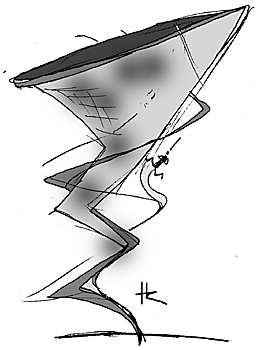


|

Illustration by Holly Randall
|
|
Arizona Daily Wildcat
Friday, February 4, 2005
Print this
The only member of the band ZZ Top without a beard has the last name Beard.
It was discovered on a space mission that a frog can throw up. The frog throws up its stomach first, so the stomach is dangling out of its mouth. Then the frog uses its forearms to dig out all of the stomach's contents and then swallows the stomach back down again.
About 1 million windmills dotted the United States landscape in the early 1930s, a time when 40 million people lived on farms and before the rural electrification program was inaugurated.
Release of energy is always at the expense of disappearance of mass. In ordinary chemical reactions, energy is released in such low quantities that the mass loss is insignificant. To lose one gram, 670,000 gallons of gasoline must be burned.
The pupils of your eyes can give clues to your emotions if the other person can see them. Your pupils dilate a little when you show interest in something, for example.
Tycho Brahe, the most prominent astronomer of the late 16th century, was extraordinarily quarrelsome and arrogant. Over a point in mathematics, he foolishly engaged in a midnight duel that cost him his nose in 1565. He was only 19, but for the rest of his life (36 years) he wore a metal prosthetic nose.
Partisan supporters of American actor Edwin Forrest and British actor William Charles Macready clashed violently outside the Astor Place Opera House in New York in 1849 - Macready was playing Macbeth there, and 22 people were killed in the confrontation.
Cat's cradle is one of the most universal games in the world. It is played in almost every culture. What is puzzling to ethnologists is that widely scattered peoples - Maoris of New Zealand, North American Indians, Arctic Inuits and various African tribes, for example - make figures of string between their hands that are exactly the same.
The brightest star in historic times was the supernova of 1054, the Crab Nebula. It was brighter than Venus and even bright enough to be visible in daylight and to cast a shadow at night. We know of it through the astronomic records of China and Japan. No European seemed to have taken note of it at the time.
On June 10, 1958, a tornado crashed through El Dorado, Kan. The storm pulled a woman out of her house and carried her 60 feet away. She landed, relatively unharmed, next to a phonograph record titled "Stormy Weather."
Write a Letter to the Editor
|
|

|
